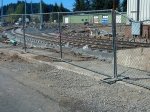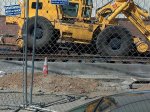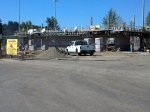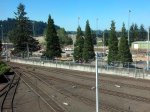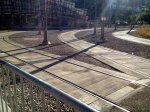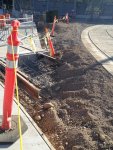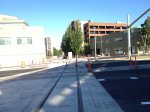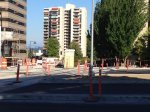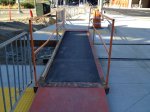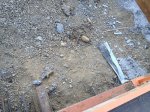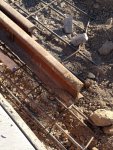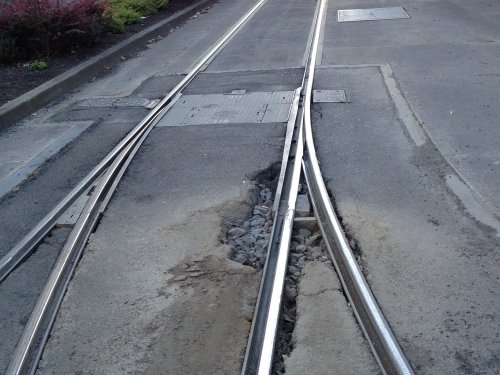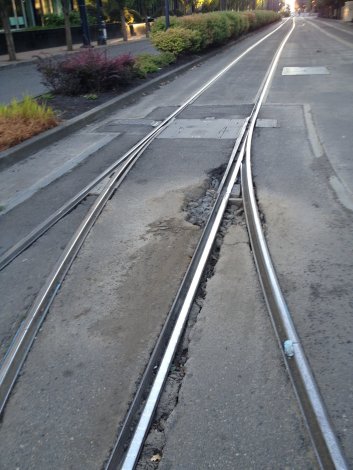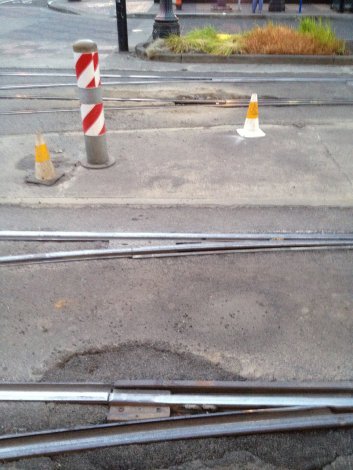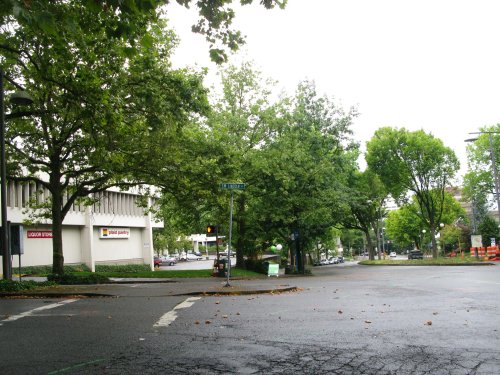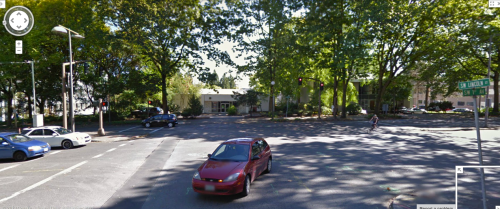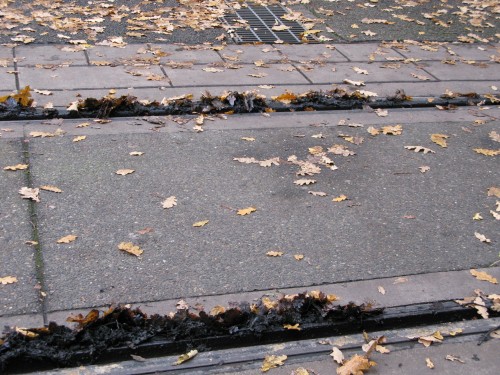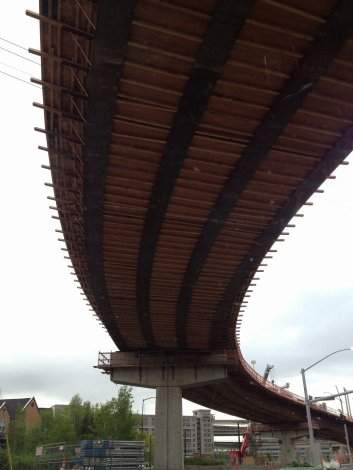Question: Why are we stopped here?
I see this question a lot, with “here” referring to many various points along the alignment. Very rarely do people get on the MAX train just to sightsee where it happens to go (though I have seen tourists do this). Instead, generally people on board have places they need to be and buses they need to catch, and as a result they get anxious when a train is stopped longer than a normal platform dwell time.
The most common cause is typically waiting for other trains to clear, and frequent “hot spots” where the wait is most likely due to rail traffic include:
Steel Bridge
All roads (well, MAX lines) lead to the Steel Bridge, and as a result you can find yourself waiting to cross it since all trains go through here. And of course, if there is a bridge lift, maritime traffic takes priority over rail so you’ll also be waiting if that happens, to say nothing of the delays from trains stacking up during the lift.
 Red Line train crossing the Steel Bridge
Red Line train crossing the Steel Bridge
Under normal operating conditions, a delay might happen on the span itself. A westbound Red or Blue Line train like the one pictured above will be held at signal 14 if a Green or Yellow Line train is crossing the bridge heading toward Rose Quarter. The reason for this is that the tracks cross each other:

This angle looking down on the western side of the bridge works well to illustrate this since the sun is reflecting off the rails making them easier to see. The two tracks coming straight down in the middle of the bottom of the picture are for Yellow and Green Line trains. The ones going off to the bottom right corner are for Red and Blue Line trains. You can see that a westbound Blue or Red train (coming in from the left track at the top of the picture) needs to cross the path of an eastbound Yellow or Green to continue into the Old Town/Chinatown platform. An eastbound Red/Blue does not have this conflict with a westbound Yellow/Green, so you won’t see those trains waiting, but westbound Reds and Blues will wait on the span until the incoming Yellow or Green is clear.
 Signal 10 at Old Town/Chinatown – the switches are set but the cars crossing in front of the train still have a green light (pre-empt signal refresher)
Signal 10 at Old Town/Chinatown – the switches are set but the cars crossing in front of the train still have a green light (pre-empt signal refresher)
Similarly, if a conflicting move is in progress or switches aren’t yet set properly, trains waiting to cross the bridge eastbound will be held. This is why you may find yourself waiting at Old Town/Chinatown on a Red or Blue train – your operator is waiting for a permissive aspect on signal 10, but won’t get one if a Yellow or Green is starting to go eastbound over the bridge (and those trains can be held at signal M26) if a Red or Blue is already crossing.
On the other side of the bridge is Rose Quarter, which is complicated enough to get its own post. In short, Reds, Blues, and Greens can generally move through here without conflict (e.g. you can have a westbound Blue leaving RQ at the same time an eastbound Green comes in without any problems) but since the Yellow Line turns north here and crosses the other tracks, Yellow Line trains can only move through the Rose Quarter interlocking at the same time as other Yellow Line trains.
 Two Yellow Line trains making a parallel move
Two Yellow Line trains making a parallel move
So if you are sitting westbound at Rose Quarter for longer than expected and there’s no bridge lift in progress, most likely your operator is waiting for a Yellow Line to get out of the way. And on the flip side, if you’re on a Yellow Line sitting at IRQ waiting to cross the river into downtown, there’s probably a Red, Green, or Blue going through that has to clear before you can move. Trains heading off the span into Rose Quarter may be held at signal 16G if a conflicting move is in progress.
Gateway
 Eastbound from Gateway
Eastbound from Gateway
The fishhook (not used to catch prostitutes) is the biggest time sink at Gateway. It’s a curving stretch of single track with a 10mph speed limit used to connect Red Lines with the alignment going north on I-205 toward the airport. In the above picture, the track diverging to the right off the eastbound main is the start of the fishhook. Since Red Line trains use this to come in and out of Gateway, in this part of the alignment where the picture was taken, westbound Reds will actually be traveling in the eastbound mainline for a short distance. So if you’re on an eastbound train at Gateway not going anywhere, take a look to your right over toward the fishhook. The odds are good that an inbound Red Line got through their signals before your train’s operator selected at Gateway, and it’s making its way up the fishhook into Gateway. Your train can’t move until they’re clear.
 Red Line coming off the fishhook as a Green Line waits in the auxiliary track
Red Line coming off the fishhook as a Green Line waits in the auxiliary track
 Green Line train heading into Gateway from Clackamas
Green Line train heading into Gateway from Clackamas
There can also be delays for Green Lines coming in to Gateway, but since that alignment has double track, it does not present the same problems as the single track fishhook does (sometimes a brief wait at the SE Main St platform or at the intermediate signal if a Blue Line is going through here).
Downtown/Goose Hollow with Conga Lines

The above picture is something of an extreme example from an evening when a switch by Beaverton TC broke and trains were backed up all through downtown. But it’s not uncommon for trains to end up forming a conga line during rush hour. In this picture, the platforms are near each other and it’s not a problem (from a safety perspective) for the trains to be that close. However, once they get to Goose Hollow, they move into ABS territory which involves much greater spacing between trains and trains traveling at higher speeds. A westbound train at Goose Hollow can’t proceed until its leader passes a signal in the tunnel prior to the Washington Park platform. You’ll hear the train waiting to proceed call this in on the radio as being “on a red at Goose” – because you can’t see into the Goose Hollow platform until you’re almost into it, trains waiting at Goose Hollow will let Control and their followers know that they’re occupying the platform, in which case the train behind can wait at Kings Hill instead of at the intersection right before the platform.
ABS Territory – Intermediate signals
If you’ve ever been on a train in ABS territory (in particular east of Hillsboro but west of Goose Hollow and east of Lloyd Center to PDX, Gateway, or Clackamas) and the train slows to a crawl between platforms, sometimes coming to a full stop before resuming normal speed, that means your operator was approaching a red ABS signal:

This is a safety measure in high-speed travel areas. There are intermediate signals between many of the platforms, and if your leader is still between the signal in front of you and the next signal, your train will have a red light that will trip you if you try to go past it. This prevents trains from getting too close at high speeds. Passengers won’t always notice this one, because it’s generally preferable to drop your speed and creep up to the signal hoping it turns yellow before you get there instead of immediately coming to a stop when you see a red (it’s best to avoid stopping a train away from a platform when possible). But if you get all the way up to the signal and it’s still red, your operator will stop the train until the signal turns yellow. This informs the operator that the train in front of them is now far enough ahead that it is safe to proceed.
Waiting for Relief
Aside from areas where trains are stopped while waiting for other trains to clear, I’ve also seen people ask why trains have to switch operators while still in service. Although there are some tripper trains that will just go yard to yard or make one round trip and then go back to the yard, most trains are in service all day. So each line has relief points built in where one operator’s shift ends and another’s begins. For the Red Line, this is Beaverton TC and as a result you won’t notice any delay because the relief will happen while the train is on layover. For the Blue Line, reliefs are generally at either Elmonica or Ruby Junction, though there are a couple of runs that are relieved at Beaverton TC and Gateway. For the Yellow and Green Lines, all reliefs are at Gateway.
I’ve mentioned this before, but a relief operator will call into Control with their train number and the word “relief”. After Control acknowledges the call, the relief operator responds with their badge number and lets the controller know if he or she is signed in and has train orders. The controller will let the operator know if there’s anything important going on they should know about (sporting event, service disruption, etc).
Generally speaking this process does not take long so these aren’t long delays, but more importantly, there is time built into the schedule for reliefs:

This is an excerpt from a paddle, or rail schedule. The plus sign after the time means 30 seconds. So to read this, the train arrives into Gateway heading toward PSU at 1:28:30pm But that train is not scheduled to depart until 1:30:30pm, giving the relief operator two minutes to call Control.
This is one of those little things I wish TriMet would publicize – I know passengers get frustrated because from their perspective, they’re sitting at a station for 2 minutes not doing anything, and now they think they’re late. However, they’re actually not late at all, the schedule is designed for the relief and the train will be leaving when it is supposed to.
Other Delays
These were the main reasons why a train will be stopped for longer than normal platform dwell service. Of course, countless things could come up in a day that will cause delays and result in trains holding – police activity, medical emergencies, a train or alignment malfunction, a car in the right of way (since that seems to happen about once a week). In those instances, your operator will likely be doing what they can to keep you posted as information about the delay and when things will be moving again becomes available. However, if you’ve been sitting for 3 or 4 minutes without any explanation, it’s ok to use the emergency intercom and ask what’s going on – operators are trained to keep passengers informed (even a “Ladies and gentlemen we’ve been asked to hold here, I will let you know when we will be moving again” when Control doesn’t give an explanation for the hold is better than not saying anything at all to passengers).
How you can help prevent delays
 Yes, you.
Yes, you.
Given the delays that can happen around the Steel Bridge, Rose Quarter, and Gateway if trains aren’t on schedule, it’s important for passengers to do their part and not contribute to any delays. Much like how a green light will eventually turn yellow and then red when you’re driving, a train won’t have a permissive signal indefinitely. If you’re downtown, on Interstate, or on Burnside, you can see the signal start to time out when it does this:

A train can’t enter the intersection when a pre-empt is displaying this aspect because it won’t clear the intersection before cross traffic gets a green light. ABS and ABS-pre-empt combination signals will go back to red when they time out.
Although you might think it’s polite to hold the door open for someone running for the train or trying to buy a ticket, what you are actually doing is making the operator miss their signal because it timed out and now they have to wait again. This can mean your train will be late getting to one of those traffic-heavy areas, and what you thought would just be a short delay to help a late-runner has turned into a 5 minute or more delay. On the transit mall, causing a train to miss a signal not only delays your train but buses as well.
And yes, it bears repeating, this is also why an operator is not likely to reopen the doors if the train is stopped with the doors closed even if you come running up to it. Once an operator calls the signal, it’s time to be ready to move as soon as the signal is permissive. This helps the train stay on schedule and minimizes the likelihood of interrupting everyone’s trip by needing to stop and wait further down the alignment.
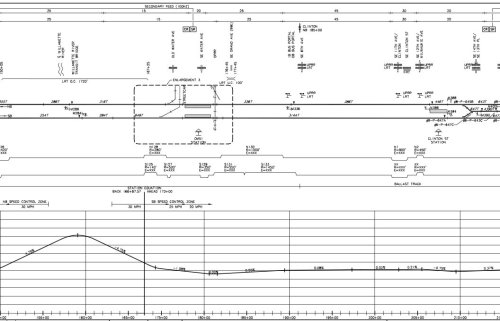 Orange Line’s new bridge, OMSI, and Clinton platforms
Orange Line’s new bridge, OMSI, and Clinton platforms 


